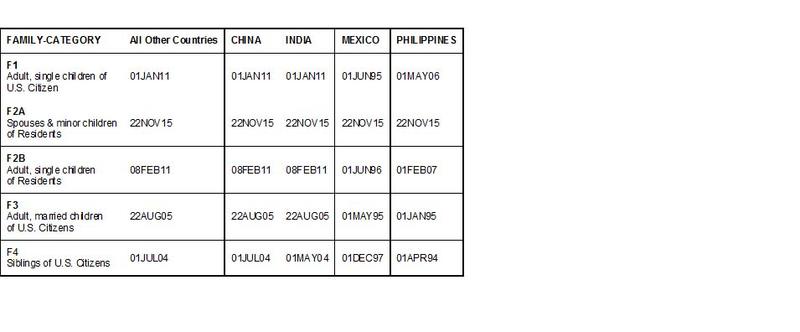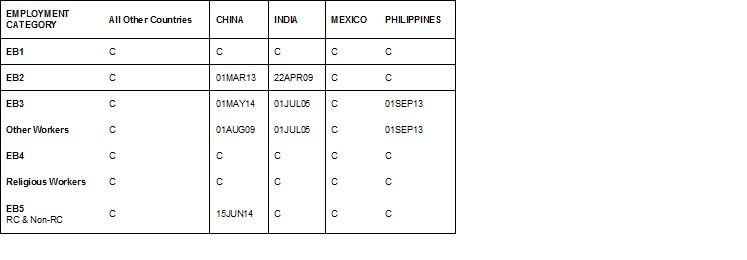Immigration News & Updates eNewsletter
eNewsletter
POSTING DATE: OCTOBER 3, 2016
Learn More About:
Immigration News & Updates eNewsletter © 2011 - 2016
For questions about U.S. Residency, Green Cards and Immigration Visas, Visit our Website at: www.ImmigrateToday.com or call our office at: (954) 382-5378
Check Out This Cool Stuff For Immigrants....
Immigration
Questions & Answers
Question: I am married living in Jamaica. My mom filed for me way back in 2006 when she had her Residency and I was single. I got married in 2010 and now I have 2 kids as well. My mom just got her American U.S. Citizenship, so I am hoping that now we can keep the original filing date of 2006 case my mom filed for me, since I have been waiting in the U.S. immigration system for so long now, thanks
This Week's Immigration News
October 2016 Visa Bulletin Allows Certain Family Members & Foreign Workers To File Early Residency Applications
Many sponsored family members and foreign workers/investors have been waiting in long lines for an Immigrant to become available, as part of the U.S. Preference immigration quota system for many years.
The reason is that the U.S. only makes a certain number of immigrant visas are available each year to immigrants, depending upon their family, employment or other visa category. And of course there is always a much higher demand each year for only a few number of immigrant visas available, which results in a waiting line.
The State Department (DOS) Visa Bulletin keeps track of how many visas were issued in previous years and how many are currently available in each family, employment and other immigrant visa category and publishes the chart each month.
To understand how an Immigrant gets his or her place in the immigrant visa line, its important to know that it is based upon a person’s “Priority Date”. The priority date for family visas is generally the date the I-130 family petition is filed.
Answer: Immigration regulations are very different for children of U.S. Residents, compared with those of U.S. Citizens. With children of U.S. Citizens, if a parent files for a single adult child (F1 category) and the child later marries, the child simply changes to the F3 category (for married children) and keeps the same original date of filing, called the “Priority Date”. The Priority Date is important because it determines where an Immigrant is in the Immigrant Visa waiting line. However, for adult children of U.S. Residents, there is only one category, F2B and that is for single adult children only, there is no immigration category for married children of U.S. Residents. So when a single adult child marries, the I-130 petition the U.S. Resident parent filed is automatically cancelled. There is no way to recapture the date that the original I-130 was filed when the child was single, since the marriage caused the original petition to be essentially void. When an adult single child of a U.S. Resident waits until after their parent Naturalizes and becomes a U.S. Citizen, they simply move to the F3 category and maintain the original Priority Date, the date the original I-130 was filed by the U.S. Resident parent.
In your circumstances, you won’t be able to keep your original priority date in 2006. Since your mom is now a U.S. Citizen, she cal file a new petition for you, which will include your husband and children and you will get a new priority date for 2016. Right now, the visa line in the F3 category for married children of U.S. Citizens is 2004, so you have another 12 years or so to wait. I hope this was helpful to you.
For an employment sponsored visa, it can be the date the Labor Certification or employment based immigrant visa petition such as an I-140 was filed.
In order to be allowed to immigrate to the U.S., Immigrants must wait until the monthly chart issued by the DOS shows that their particular family or employment, or other visa. And to confuse things further, the countries China, India, Mexico and Philippines have their own column, since there has been so much demand for visas from these nationals, that visa waiting lines are often much longer for most visa categories. For instance, the typical waiting time for a sibling of a U.S. Citizen for most countries is 12-14 years. For a Mexican sibling, its about 19+ years and for Philippine siblings its about 24+. Wow!
Until recently, there was only one chart for family and another for employment based visas, then under a new Obama program to “revolutionize” the immigrant visa system, a second chart was created called “Dates for Filing Visa Applications”. Now each month there are two charts, the original chart called “Final Action Dates” and a new chart called “Dates for Filing Visa Applications”. The first chart is the same old chart which has dates of visa availability, according to an Immigrant’s priority date. The second chart, Dates for Filing Visa Applications” has earlier dates, which potentially allow Immigrants who are in the U.S. legally (or otherwise eligible) to file for adjustment of status for a Green Card. The confusion has been that even though the DOS has been publishing both charts, the USCIS only allowed Immigrants to use the second chart, Dates for Filing Visa Applications”, to file for residency early on and then stopped. Now, the USCIS publishes a notice each month which notifies Immigrants whether or not they can use the earlier Dates for Filing Visa Applications chart or not. But finally, for October 2016, the USCIS has announced that it will allow Immigrants to use the Dates for Filing Visa Applications chart for the month of October, for those who have priority dates on or before the dates on that chart or where "C" is indicated, meaning current for all priority dates. This is only for October 2016 and could once more not be available for November and months to come, but for now, those who qualify can file for adjustment.
Its important, however, to confirm that you are eligible before filing for adjustment, since filing for residency when you are not eligible can have very negative immigration consequences. Some tips:
1) make sure that your priority date in your immigrant visa category is at least the date on the October Visa Bulletin for Dates for Filing Visa Applications, or there is a "C" meaning current for all priority dates. If your date is after that date, you do not qualify and should not file for adjustment of status (AOS).
2) Even if your priority date is on or before the date on the chart, if you are not in legal immigration status in the U.S., meaning your I-94 or authorized stay has not expired, or you have not violated your status in some way, for instance an F-1 student who has quit school, or H-1B worker who is not employed by his sponsoring employer, etc., you are not eligible for AOS and should not apply, unless you are eligible under an exception, like 245(i). This is particularly true of family Immigrants who entered the U.S. legally, but allowed their immigration status to expire.
3) If you do qualify to file for AOS, you must file and have your I-485 application actually received by the USCIS on or before Oct 31st. Those applications received by the USCIS after that date will be rejected, if the November Visa Bulletin does not provide the same allowance for filing AOS.
4) Finally, don’t become a victim of an immigration scam. As part of this AOS availability, there will be plenty of scammers who lie to Immigrants, steal their money, hopes and dreams by promising immigration benefits to those who do not qualify. Avoid being cheated by seeking the advice of a qualified immigration attorney before filing to confirm eligibility.
For more information about your eligibility to file for adjustment
in the U.S., call our office at: (954) 382-5378
Here are the AOS dates for October 2016:
Helpful Immigration Tips You Can Use...
Obtaining Evidence of Residency When You Lose Your Green Card
or File For Green Card Renewal
Under this policy, USCIS personnel at USCIS Field Office Application Support Centers can provide extension stickers to Residents at the time of their Biometrics appointment. The extension stickers are valid for nine (9) months. Residents who have already attended their Biometrics appointment and did not request or receive the extension sticker can make an INFOPASS appointment to return to the local USCIS office and receive the extension sticker at that time.
Make an Infopass Appointment at your local USCIS office:
Since USCIS processing times for Green Card renewal or Green Card replacement applications (Form I-90), can exceed 6 or more months, it often causes problems for Residents who require proof of legal immigration status for Driver’s License and other renewals. As a result of these long delays, local Field Offices are authorized to provide Residents with a Green Card extension sticker, affixed to their expired cards, to provide proof of their continuing legal Residency status in the U.S..
Dual Citizenship - keeping both your foreign and U.S. Citizenship
Contrary to popular belief, Immigrants who naturalize to become U.S. Citizens do not automatically lose the citizenship of their birth country or the acquired citizenship of any other country prior to becoming a U.S. Citizen. U.S. Immigration laws allow dual nationality, which means that a person is a citizen of two or more countries at the same time. Persons may have dual nationality by automatic operation of different laws rather than by choice, for example, a child born in a foreign country to U.S. citizen parents may be both a U.S. citizen and a citizen of the country of birth.
Similarly, a U.S. citizen may acquire foreign citizenship by marriage. Naturalized U.S. Citizens need not lose the citizenship of any other country, unless the foreign country requires that person to choose one citizenship or another. Finally, a person who is automatically granted another citizenship in a foreign country does not risk losing U.S. Citizenship unless they apply for it with the intent to give up their U.S. Citizenship. Good to know!
Immigration How To:
How Do I Keep My Dual Citizenship?












